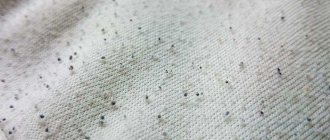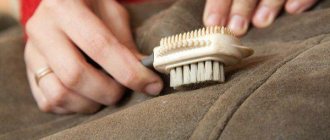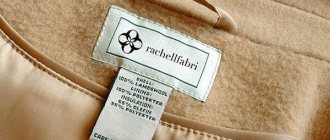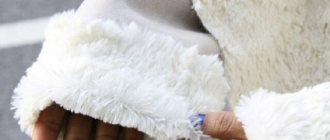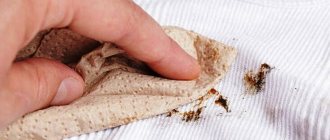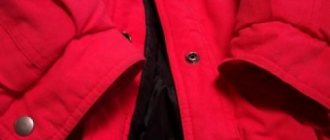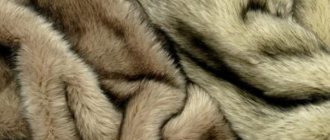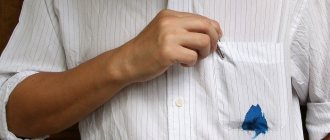How to clean a coat made from natural fabric
The following expert recommendations will help you quickly remove stains and clean dirt from a demi-season, children's, men's, women's or winter coat and refresh the color:
Rice. 1 — Brush for cleaning coats
- Before removing dirt and dust from your clothing, try this method on an inconspicuous area to see how the fabric reacts.
- You can clean off any remaining dirt and debris with a soft dry brush or a roller with adhesive tape.
- A cotton swab dipped in a solution of strong black tea will help you quickly and effectively add shine to shiny dark items.
- Greasy areas on the collar and sleeves can be refreshed with a mixture of ammonia and salt in a ratio of 1:4. Rub the problem areas, and then remove the residue with a brush.
Clean any stains from the edge to the center so that streaks do not appear on the fabric.
Cashmere
A cashmere coat is worn not only in winter, but also in the off-season, so it has to be cleaned more often. For cashmere, a quick hand wash at 30 degrees is recommended. The material is very soft and delicate, and therefore very demanding when it comes to cleaning products, which are important to choose correctly. You can remove stubborn stains on cashmere clothes without washing them using liquid soap foam and a soft brush. Then the product must be rinsed; if it is light, add a mild conditioner. If a colored coat has turned white, it is better to go to the dry cleaner - perhaps the cashmere has faded and requires dyeing.
You need to dry the coat in a terry towel - lightly wring it out, then lay it out, straighten out all the folds and keep it until completely dry. If it is not too heavy, straighten it on a hanger and hang it over the bathtub to dry. Avoid exposure to hair dryers and batteries.
Rice. 2 - Dry your coat on a hanger
Wool
A classic felt coat made from this material (from Australian raw materials, from alpaca and acrylic, from angora, from llama, from felted, from boiled, from camel, from Italian sheep, from sheared or from sheep wool) should be carefully washed by hand with water added washing conditioner. To prevent a 100% wool wool or felt product from becoming shiny, greasy areas are treated with a mixture of equal proportions of alcohol and vinegar. Before storing, coats made from alpaca and other wool are knocked out of dust. A dark coat with a knitted collar is wiped with black tea, dried stains are removed with steam, threads are removed with a velor brush.
Drape
A classic light-colored drape coat with a collar and a belt is treated with “Vanish” - the product is poured onto the stained area and followed the instructions. If the instructions for clothes made of drape prohibit the use of even delicate washing, treat the stains with a soap solution. Sleeves, lining and pockets are gently rubbed, the product is washed off with clean water and blotted with a dry cloth. You need to dry the item in a well-ventilated area.
Tweed
A tweed coat requires special care. To remove dust, you can simply vacuum it; after contamination, the stain is dried and the dirt is brushed off. Stubborn stains can be blotted with soap suds and combed with a damp brush. It is not advisable to wash the item in a machine - it is better to use hand washing with a water temperature of no more than 30 degrees. Drying is carried out on a horizontal, flat surface between two towels. Iron tweed from the inside out, placing a damp cloth between the iron and the fabric - otherwise, the disadvantages of ironing will be obvious: stains and singed fabric.
Rice. 3 - Iron a tweed coat through the fabric
Velours
A velor coat requires careful handling; it cannot withstand brute physical force. Washing with strong detergents and using hard brushes is prohibited. The advantage of this material is that it does not have to be washed every time: a velor item can be vacuumed, dried stains can be wiped off with your hands or a suede brush. Greasy marks are removed with bread crumbs, other stains are removed by steaming. When washing, you should choose a delicate cycle without intensive spinning. Or you can wash the product by hand, avoiding friction and twisting. Things are dried on a hanger in the shade.
Leather
A leather coat made of eco-leather or natural material can be cleaned from dust with a regular damp cloth. A mixture of 2 tbsp will remove light stains from a python jacket. l. ammonia in a glass of water with soap. The greasy areas on the seal collar are wiped with alcohol, lemon juice, and then with a glycerin solution. Salt stains are removed with table vinegar.
A leather item should not be soaked for a long time, but a dusty or greasy lining should be washed regularly - turn the item inside out, soap it, remove road stains and rinse with a little water or wipe with a damp cloth. After washing, hang the coat on a hanger and dry.
Cotton and natural fabric
Things made from such materials are cleaned twice a year. These include clothes made from cloth, fabric, bouclé or cotton. Dust is wiped off with a soft brush or a sticky roller. Cloth or clothing made from bouclé fabric is treated with a weak soap solution. They can be washed in a washing machine on the delicate cycle and water temperature up to 30 degrees. You cannot use bleaching agents, but you can add glycerin or dry mustard. It is best to dry a natural item between towels, rolled up. Drying should be done in a horizontal position. The item should be ironed carefully, through gauze.
Suede
Rice. 4 – Suede cleaning products
A suede coat is cleaned of dust with a cotton swab and ammonia. Movements go along the pile. To remove oily and shiny areas on suede items, dilute a little soda in 100 ml of milk, apply the solution for a couple of minutes and brush off. Or sprinkle greasy marks with starch and brush them off. Wipe away any stains with a crust of bread or an eraser, and hold the creases over steam.
Rinse very dirty suede in warm soapy water, rinse in clean water - without soaking, rubbing or twisting. Then, for softness, rub with a glycerin solution (half a teaspoon per liter of water). Dry the product on a flat surface on top of a dry towel. Iron from the inside out only.
Lined with wool and down
Coats with swan down or wool filling should be washed on a delicate cycle with a special gel. Then you should rinse the product to avoid streaks. Items with insulation should be dried in a straightened form, spread out on a horizontal surface.
Mohair
The mohair coat is cleaned with a dry brush with thick, medium-hard bristles in the direction of the fibers, then repeated with a damp brush. A mohair item trimmed with fur can also be cleaned with foam - apply it for 10-15 minutes and remove. Lay the mohair coat horizontally, crumble the bread thickly between the pile, leave for 10 minutes and rub until crumbs appear. Carefully comb out any slag from the pile and go over it with a damp microfiber brush.
Fur
Rice. 5 - Steaming fur
An item with fur trim from a muton, rabbit, nutria or other animal should be thoroughly beaten. To clean a beaver coat, spray the fur with warm water, let it dry and comb it, or use a steamer. To restore shine to the product, treat it with lemon juice or vinegar dissolved in water 1:1.
To prevent the fur from turning yellow, moisten it with a solution of a glass of water, a tablespoon of salt and half a tablespoon of ammonia, dry and comb. You can clean fur from debris with hydrogen peroxide and pet shampoo. Wipe the short pile in any direction, and the long pile strictly according to its height.
How to Clean a Faux Fabric Coat
Such materials require no less careful care. There are several ways to clean a coat at home - they are chosen depending on the type of fabric and the degree of its contamination.
Neoprene
This is artificial foam rubber covered with fabric on both sides (such things are, for example, in the Mango collections). The material is resistant to water and abrasion. It can be washed with soft powder in a washing machine at 30 degrees. Drying is carried out in the shade.
Viscose
An item made from this material can be washed by hand or in a machine:
- Do it yourself: pour warm water into a basin, add stain remover, saturate the fabric, rinse without rubbing, rinse with warm water and hang to dry without spinning.
- In the car: set the delicate mode, add soft gel and conditioner, remove the spin mode.
Both methods are suitable for removing both small and stubborn stains from viscose items.
Synthetic
A down jacket made of acetate, polyester or any other synthetic material can be machine washed with powder on a delicate cycle. Choose minimal spin; after washing, hang the product on a hanger to dry.
Faux suede
Washable by hand at a temperature of no more than 30 degrees with delicate foam. An artificial suede item should not be completely wet, only the contaminated areas. Clothes should not be rubbed, wrung out or twisted, or dried in a radiator or in the sun. Dry cleaning is possible: grease stains are removed with ethyl alcohol, oil stains are removed with ammonia, and all other stains are removed with soap solution. After drying, the pile should be combed with a rubber brush.
On padding polyester
A synthetic winter coat can be found in any wardrobe, but depending on the type of filling, it can be cleaned differently. Glued synthetic padding can only be cleaned using the dry method or wiped with a damp cloth. Thermally bonded ones can be washed in a machine at a temperature of 30-40 degrees in the delicate or synthetic wash mode; you must also turn on the additional rinse function. Choose liquid detergent. The coat is wrung out by hand, wrapped in a terry towel, and dried on a hanger. It can be ironed through fabric.
Polyester
Things made from it hardly wrinkle and wash well. Dust is removed with a brush or shaking, stains with stain remover, table salt, borax solution or soap. Polyester items can be washed by hand in warm water or in the washing machine with a mild detergent without bleach.
Fleece
Rice. 7 - Fleece coat
The fleece coat is machine washable, but it is better to clean it by hand. You can soak the product in a soap solution (neutral gel without enzymes, laundry soap, soda ash with hard water) for no longer than half an hour. Drying - in a horizontal position naturally. An old razor will help with pellets. It is not advisable to iron the coat - it will straighten itself on the hanger.
Raincoat fabric
A Bologna coat or a raincoat coat can be washed in warm water up to 40 degrees. Dirt is removed with liquid detergents without chlorine or bleach. Washing is done by hand or in the delicate cycle of the machine. Greasy stains are removed with a soft sponge. Clothes are dried naturally and ironed at moderate heat.
Stains are removed in the following ways:
- fatty – vinegar solution (half a teaspoon per glass of water) or whey;
- greasy places - a solution of ammonia and gasoline 5:1;
- oil - salt and alcohol;
- traces of rain and mud splashes - soap solution;
- cosmetics – purified gasoline.
Things are ironed with a steamer or through a damp cloth.
Nubuck
Clean by steaming, remove dust with a rubber brush. Grease stains are removed using a mixture of gasoline, starch or talc, heavy stains are removed with a solution of ammonia in water 1:4 or vinegar 1:20. For daily care of nubuck products, you should buy a foam cleaner and water-repellent impregnation.
Cleaning coats of different colors
Depending on the color of the products, their care may vary. There are 3 types of possible cleansing that help care for your coat:
- Dry cleaning - with a brush, powders without water.
- Wet – steaming, treatment with solutions.
- Wash – by hand or machine.
Before cleaning, the coat is shaken out, everything unnecessary is removed from the pockets, rubbed with a brush and a decision is made on how to remove the stains.
Light fabrics
Beige, white or any coat of delicate shades should be treated with gentle non-dyeing products. A milk-soda solution, white bread crumb, gel and chlorine-free powders are suitable. Grease stains are soaked with baby powder or starch, wine stains with salt, tea stains with alcohol or glycerin with ammonia.
Dark fabrics
A black coat also requires special care. You can remove small debris from black, black-gray or other dark products with warm water or rye bread crumbs. Grease stains can be removed with a synthetic detergent or steamer. Regardless of the color of the coat, before cleaning, read the instructions on how to wash it correctly so that it does not shrink.
Rice. 9 – Steaming a dark coat
Colored fabrics
Yellow, red, pink, gray, coral or any other bright short coat or coat is cleaned with a vinegar solution, which adds richness to the shades. For cleaning, prepare a mixture of 3 liters of water and a glass of vinegar. You can use classic table, white or apple cider vinegar.
Cleaning different stains
All dirt on the products is cleaned from the edges to the center, otherwise the work becomes noticeably more complicated. Stubborn stains can be removed by placing an absorbent patch on the back of the fabric.
Grease stains
You can get rid of greasy and greasy marks with a solution of gasoline, ammonia and soap. Fresh stains are sprinkled with talcum powder and starch.
Fuel oil
Fuel oil can be cleaned in the following ways:
- applying fir or eucalyptus oils and subsequent washing;
- caustic soda;
- laundry soap.
Rice. 10- Laundry soap to remove stains
Old stains can be removed with purified gasoline, car shampoo, ammonia, acetone or toluene. Apply the products to the dirt, hold for a couple of minutes and rinse with soapy water.
Dirt, dust, splashes
You can eliminate their remains with a paste of salt and warm water, a mixture of ammonia and hydrogen peroxide in equal proportions. Stubborn stains from street dirt or splashes from a puddle are removed with pure hydrogen peroxide, Antipyatin or any stain remover, for example Vanish.
Paraffin and wax
There are several ways to remove traces of a candle:
- Hot: steaming, ironing over a napkin.
- Cold: you can remove traces of a candle with alcohol and washing with soap, turpentine, gasoline, and solvent.
If the fabric allows, the stain can be scraped off with a razor blade or blunt knife, frozen in the freezer for a day, and chipped away.
Blood, sweat, vomit
You can eliminate sweat marks by soaking in laundry soap, Fairy soap or bleach, soda slurry, vinegar, aspirin, salt with or without ammonia. You can clean a blood stain by soaking it in a saline solution and washing it in cold water; if that doesn’t help, use hydrogen peroxide. You can get rid of traces of vomiting with cold water and soda, ammonia or Vanish.
Plasticine and chewing gum
Rice. 11 – Freezing gum with ice
You can remove traces of chewing gum and plasticine with vinegar. Pre-freeze the clothing and pin off the main part of the elastic. Stains from it are wiped off with stain remover, acetone or nail polish remover.
Soot and resin
Black sticky marks from fresh pine bark and soot stains are wiped off with kerosene. Apply to the stain for 20 minutes, and then rinse the clothes or wash with soap or powder.
Pen
Traces of ink are removed with a mixture of ammonia and baking soda in a glass of water. Soak the ballpoint pen stain in the solution, then wash well with laundry soap.
Whitewash, chalk, powder
A wet wipe with ethyl or ammonia or vodka will help against these substances. Leave it on the stain for 10 minutes, then sprinkle with baking soda and wash with warm water.
Animal fur and droppings
You can remove the hair of a cat, cat or dog with wet hands, combing the pile from top to bottom. You can also get rid of dog, cat hair, bird fluff or hairs of other animals with a sticky roller for clothes or ordinary tape. You can remove the remains of animal droppings, hair and lint with ammonia, salt and soda, potassium permanganate, and vinegar. Rub the stain with a weak solution of these products, and then wash in soapy water.
Solid oil
Dissolve 2 tbsp. l. vinegar in 500 ml of water, moisten a cotton pad and treat the stain. Then wash with washing powder or gel and dry the clothes.
Rice. 12 — Solid oil
Sticky spots
Sweet traces from syrup or jam can be removed with ordinary hot water - it dissolves the sugar. If the stain is old, use soap.
Lipstick, paint, oil
Cosmetic stains from foundation, pencil, powder or any other cosmetics, especially dried ones, are removed with alcohol, borax or turpentine. Fresh lipstick should be sprinkled with salt and washed with water and vinegar. Oil stains from machine oil, blue, ink or glue are removed with acetone. Dried glue can be removed with wine alcohol or glycerin.
Mold
Dissolve 2 tbsp in a liter of water. l. salt, add a little ammonia, boil and dip the contaminated clothing into the solution, then scrub with a brush. Hyposulfite, denatured alcohol, bleach, and acid whey from milk can also deal with mold. Apply them to the stains, wait 10-15 minutes and wash off with soap.
Paste
An effective way to remove ink is to use a solution of a teaspoon of ammonia in a glass of water. Soak a swab in the mixture, apply the paste stain with a ballpoint pen and rub. For greater effectiveness, warm the solution.
Liquids
Vinegar and alcohol will help remove stains from splashed water and get rid of streaks. Mix them in equal parts and treat the contaminated area. Traces of wine, beer and coffee are removed with a mixture of 2 parts pharmaceutical glycerin and 1 part ammonia.
Dirt, dust, splashes
You can clean the fabric from them with a soap solution and ammonia - add a tablespoon of soap and ammonia to 100 ml of warm water, saturate the fabric and treat the dirt, remove the residue with a damp cloth. This method is especially relevant in the fall if your coat has been splashed with mud from a puddle.
Rice. 13 – Splashes from a dirty puddle
Egg
Egg whites, as well as yolks, are removed with a soapy solution from water and dishwashing liquid. If its use does not help, add a little ammonia to the solution.
How to remove the smell of sweat from a coat under the armpits
Make a solution of 4 parts water, 1 part ammonia and 1 part ethyl alcohol. Mix well, spread over the lining and brush, then rinse with warm water.
Magic recipes
So, what can you use to clean a wool coat at home?
- At first, the brush is moistened in clean water;
- If the product is heavily soiled, prepare a soap mixture. Dissolve 1 tsp. liquid laundry soap in 1 liter of water or grate a piece the size of half a matchbox on a grater. Do not rub stains inwards, especially on white material. Leave the soap solution on the surface for 10-15 minutes, and then carefully blot it with a napkin.
- Grease stains can be cleaned with clean gasoline, but contact is made from the wrong side. Open the lining, soak a cotton pad in gasoline and carefully, from the edges to the center, treat the stain;
- Traces of food and spilled drinks, especially fresh ones, can be easily cleaned at home with a composition of 96% alcohol and 72% vinegar. Combine equal parts of the substances, dip a damp cotton swab into it and rinse the surface;
- Greasy areas are refreshed with a mixture of salt and ammonia. Combine 4 parts salt and 1 part alcohol, and rub the resulting slurry onto the stains. After a couple of minutes, you need to clean the areas with a soft brush. If you mix the ingredients in reverse proportions, you get an ideal mixture for cleaning white woolen items;
- A black woolen coat can be cleaned with a sponge soaked in strong tea leaves - this will refresh the color and remove dust;
- If you are interested in how to quickly clean 100% wool, stock up on glycerin and ammonia. Mix the ingredients in a 2:1 ratio and treat stains and dirty areas with the mixture. The remaining areas are cleaned with warm water without soap;
- You can buy shampoo for wool products in the store and prepare a soap solution from it. Heavy dirt can be removed with wool stain removers, but when purchasing, carefully read the composition - it should not contain alkali or chlorine.
Cleaning methods
You can remove stains and dirt from clothes using different methods. Dry cleaning is suitable for delicate fabrics, wet cleaning is suitable for medium-weight fabrics, and washing is suitable for non-capricious items. Where can I return the product if it is shiny? The best thing is to go to the dry cleaner.
Dry cleaning
Includes the use of powders or improvised means without water. For example, this is bread crumb, talcum powder or just a brush.
Rice. 14 – Dry cleaning coats
Folk remedies
If desired, any housewife can deal with stains at home herself, without washing and without dry cleaning. You can remove various types of contaminants yourself, with your own hands, even using traditional methods.
Brush
Rubber is suitable for suede and nubuck, tooth - for wool and tweed. Brush in the direction of the nap to remove dust and dirt.
Bread
To clean dark products you can use rye, for light ones you can use loaf. Roll the crumb into a ball and move it over the stains, collecting dust and dirt.
Soapy solution
Dissolve a couple of tablespoons of liquid soap or shampoo or stain remover in a liter of water. Apply the mixture to the stain, remove the foam with a damp sponge and dry the item.
Damp cloth
To refresh the color of the coat, just run a cloth soaked in warm water over the pile. An aqueous solution of salt, soda or vinegar will help in the fight against pollution.
Petrol
Used to remove greasy and greasy stains. Soak a cloth in purified gasoline (for lighters), rub the dirty area, and wash with soap.
Soap and ammonia
Mix them in equal proportions to make a paste. Apply laundry soap and ammonia to the contaminated areas and rub, rinse with a damp sponge and clean the item with a brush.
Ammonia, starch and glycerin
Combine the substances in equal proportions and mix with water. Treat the stains with the resulting solution and rub them for quick removal.
Salt and ammonia
Combine the above ingredients to form a paste, apply it to fresh or old stains, and rub. Rinse with clean water and dry the product well.
Vinegar
Dissolve a teaspoon in a glass of water, soak a cloth in the mixture and rub the stained areas well. This method refreshes the color well and eliminates unpleasant odors.
Milk and soda
The method is especially good for light-colored items. Dissolve a teaspoon of baking soda in a glass of milk, rub the stain and remove the residue with a damp sponge.
Alcohol
Capable of removing any stubborn dirt stains and grayness. Use undiluted denatured alcohol for thick fabrics and diluted vodka for delicate ones.
Eraser and rye hunk
Excellent for cleaning dust and dirt from thick fabrics and suede. To remove dirt, move a piece of bread or an eraser in a circle, then brush off any crumbs.
Talc
Sprinkle the powder onto the greasy stain, leave for half an hour, and remove the residue with a brush or eraser. You can also combine talc with ammonia to make a paste that will clean off stubborn stains.
Scotch
Adhesive tape is good for working on thick fabric - it refreshes the color, removes pellets and works well with stuck pet hair.
Dry cleaning
Dry cleaning helps with stubborn stains that cannot be removed on your own. How long it takes to clean a coat depends on the type of material, type of contamination and persistence of the stain.
When is the best time to use professional dry cleaning?
It is better to give a light or colored coat to professionals for cleaning, because such things can easily be ruined using traditional methods. You should also contact dry cleaning services in the following cases:
- there is a note on the label about the product being dry cleaned;
- stains of machine oil or fuel oil appeared;
- leather coat is dirty.
Contact a dry cleaner if the stains are not removed the first time, the product is very expensive, or you are not sure that you can handle the task yourself.
Coat cleaning products
On sale you can often find various products for cleaning outerwear: aerosol, Vanish foam, Vanish shampoo, wipes, sprays, a roller with adhesive tape, a roller. All of them are applied strictly according to step-by-step instructions so as not to spoil the item.
Washing vacuum cleaners and steam generators
Wet processing of coats involves using a steamer, steam cleaner, or a device with laser steam supply. With their help, you can thoroughly clean any stubborn dirt and make the pile even.
How to clean dry?
If the product cannot be washed, read the instructions on how to dry clean it:
- Hang the item on a hanger, straighten the hems, straighten the collar, unbutton;
- Walk over the surface with a soft brush, moving in the direction of the pile;
- Remove dust and small hairs with a sticky roller;
- Don't forget the lining;
- Pay special attention to the cuffs, collar, pockets, shelves - most often these sectors look the most greasy;
- If necessary, use cleaning products made at home or purchased from grocery aisles;
- Dry your coat vertically by hanging it on a hanger.
If an item is heavily soiled, it can be cleaned with special compounds that can be easily prepared at home. With the help of some, it is easy to remove stains and refresh the appearance. As a last resort, buy household chemicals. Well, when there are absolutely no options, the woolen coat is taken to the dry cleaner. Read how to wash a down pillow, there are our author's tips.

